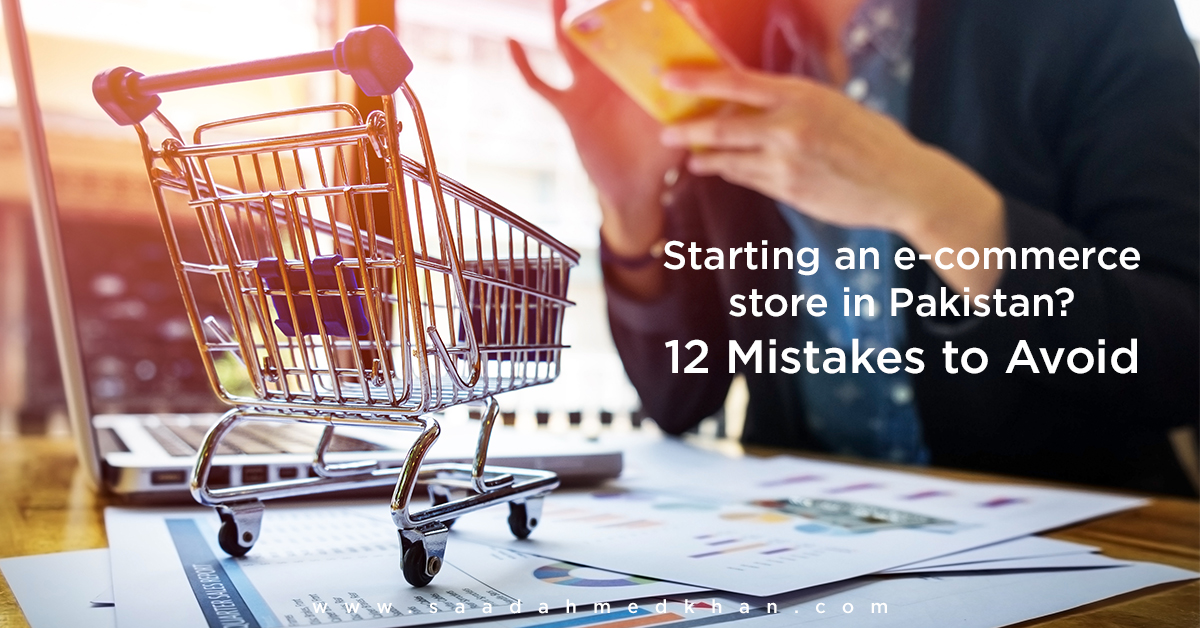Problem #1: Short term gains over long term game!
 First thing you need to ask yourself is whether you are in it for short term gain or you want to establish yourself as a proper brand and work in this field long term? If your answer is short term, then you can do whatever you feel like and make things work as you will not be able to fully benefit what the market has to offer you.
If you are the game, make an ultimate goal – like “I want to have 20,000 customers in 1 year’s time!” or “I want to be an authority in e-commerce in 2 year’s time!” etc. and make small goals to support your goal. So, your ultimate goal is your destination; and your small goals define your pathway towards your goals. Remember, the path is never straight, never easy, there will be good days and bad days. How you go through your bad day defines who you are… the trick is; never give up! Following your dream / passion / goal is never easy, you will be pushed, dragged, back-stabbed, bad mouth behind your back but your focus should be one thing and one thing only, that is your ultimate goal.
First thing you need to ask yourself is whether you are in it for short term gain or you want to establish yourself as a proper brand and work in this field long term? If your answer is short term, then you can do whatever you feel like and make things work as you will not be able to fully benefit what the market has to offer you.
If you are the game, make an ultimate goal – like “I want to have 20,000 customers in 1 year’s time!” or “I want to be an authority in e-commerce in 2 year’s time!” etc. and make small goals to support your goal. So, your ultimate goal is your destination; and your small goals define your pathway towards your goals. Remember, the path is never straight, never easy, there will be good days and bad days. How you go through your bad day defines who you are… the trick is; never give up! Following your dream / passion / goal is never easy, you will be pushed, dragged, back-stabbed, bad mouth behind your back but your focus should be one thing and one thing only, that is your ultimate goal.
Problem #2: Not focusing on branding!
 Branding is the biggest missing element from the local entrepreneurial system. Branding is defined as;
Branding is the biggest missing element from the local entrepreneurial system. Branding is defined as;
“The marketing practice of creating a name, symbol or design that identifies and differentiates a product from other products.”
Local startups don’t bother spending a dime on their branding, thought that’s the first thing they should be concerned about. Focusing on a unique brand identity would help their business stand out in the crowd. People consider these are “expenses” but I suggest they label it as “investment” in their business which will pay off well in time to come. Starting point for branding of a new business would be choosing the name and tagline; naming a business is just like naming a newborn baby! It will be the identity of your business for as long as it exists. Choose it wisely. Second step would be getting a logo made; I HIGHLY recommend getting a unique custom logo made from a professional designer but people usually don’t opt-in for that, BIG MISTAKE! Would you let your baby get an identity by an amature who don’t know jack about making a brand? No, right? Hire a professional logo designer to get this job done. Talk to the designer before handing over the project; ask them about design concepts, which type of logo would he/she would recommend, which colors will he/she use; what design elements would he/she use, etc.. Once satisfied, start off the project and make sure you get multiple logo options in the first round of drafts with multiple revision rounds. Once done with the logo, get business cards designed and printed, you will be needing them A LOT!Problem #3: Website or no website?
 Majority of the e-commerce startups avoid getting a website in initial phase; which is BIG MISTAKE! They consider it as an expense rather than an investment to their brand.
Though majority of the audience prefer to buy through different social media platforms (Facebook, Instagram, etc.) but you MUST have a website. Here are 10 reasons why:
Majority of the e-commerce startups avoid getting a website in initial phase; which is BIG MISTAKE! They consider it as an expense rather than an investment to their brand.
Though majority of the audience prefer to buy through different social media platforms (Facebook, Instagram, etc.) but you MUST have a website. Here are 10 reasons why:
- Increase customer’s trust.
- All products are properly classified.
- Proper product description.
- Properly managed inventory.
- Order processing (for customers) is easy.
- Order fulfilment is easy.
- Order tracking made easy for customers.
- Personalized shopping experience for visitors/customers.
- Reporting is made easy to get better understanding of business.
- Unlimited possibilities for organic growth through search engines.
Problem #4: Choosing the wrong e-commerce platform!
 Great, you want a website for your e-commerce store but confused which platform to choose? Your bestie suggested you to stick to Facebook but your khala ka baita who is doing graduation in computer science suggested that you use Magento as it is THE BEST e-commerce platform you could get your hands on!! Hold on. There are 100s of e-commerce platforms available but which one to choose is the toughest decisions of your startup! There are many factors involved; such as do you want managed platform or self-hosted? What would be the initial costs involved? Will there be recurring costs? What would be the uptime for the site? How do you optimize the self-hosted platform? Which hosting to choose for the self-hosted platform? These are the questions that will confuse you and everyone will give you different options based on their experience.
Here are few e-commerce platforms commonly used: (in alphabetical order)
Great, you want a website for your e-commerce store but confused which platform to choose? Your bestie suggested you to stick to Facebook but your khala ka baita who is doing graduation in computer science suggested that you use Magento as it is THE BEST e-commerce platform you could get your hands on!! Hold on. There are 100s of e-commerce platforms available but which one to choose is the toughest decisions of your startup! There are many factors involved; such as do you want managed platform or self-hosted? What would be the initial costs involved? Will there be recurring costs? What would be the uptime for the site? How do you optimize the self-hosted platform? Which hosting to choose for the self-hosted platform? These are the questions that will confuse you and everyone will give you different options based on their experience.
Here are few e-commerce platforms commonly used: (in alphabetical order)
- 3D Cart
- BigCartel
- BigCommerce
- Magento
- OpenCart
- OsCommerce
- Shopify
- SquareSpace
- Volusion
- Wix
- WooCommerce
Problem #5: Product sourcing.
 Are you opening a niche store? Or a general store?
Niche stores are targeted to very specific kind of an audience, such as; you opened up camping gear shop online targeting people who like hiking, trekking, mountaineering, camping and adventures. While the general store can target a wider spectrum of an audience such as; male & female of age group 18 to 55 living in Pakistan, who could be your potential customer!
This would give you some relaxation on capital and you will have more amount to spend on marketing instead of buying merchandise up-front.
If you are planning to import your products on a small scale, you can’t find better source than AliExpress. There are hundreds of thousands of unique products available at a very reasonable price but the down size is their shipping time (unless you pay a hefty amount in shipping charges, killing all your profit margins!), it can take anywhere from 8 days to 45 days to get your products delivered to your doorstep. At times, Pakistan customs can create problems for you and you might need extra time and amount to deal with them and pay custom duties on your shipment.
If you are sourcing your products locally, give preference to “quality” over “price” – you can always bargain the price when buying in bulk / wholesale but you should never ever, ever, ever compromise on quality. The thing that I learned with my e-commerce experience is, people are ready to pay the right price if the quality is great. Don’t focus on price, focus on BEST AVAILABLE QUALITY!
Are you opening a niche store? Or a general store?
Niche stores are targeted to very specific kind of an audience, such as; you opened up camping gear shop online targeting people who like hiking, trekking, mountaineering, camping and adventures. While the general store can target a wider spectrum of an audience such as; male & female of age group 18 to 55 living in Pakistan, who could be your potential customer!
This would give you some relaxation on capital and you will have more amount to spend on marketing instead of buying merchandise up-front.
If you are planning to import your products on a small scale, you can’t find better source than AliExpress. There are hundreds of thousands of unique products available at a very reasonable price but the down size is their shipping time (unless you pay a hefty amount in shipping charges, killing all your profit margins!), it can take anywhere from 8 days to 45 days to get your products delivered to your doorstep. At times, Pakistan customs can create problems for you and you might need extra time and amount to deal with them and pay custom duties on your shipment.
If you are sourcing your products locally, give preference to “quality” over “price” – you can always bargain the price when buying in bulk / wholesale but you should never ever, ever, ever compromise on quality. The thing that I learned with my e-commerce experience is, people are ready to pay the right price if the quality is great. Don’t focus on price, focus on BEST AVAILABLE QUALITY!
Problem #6: Product photography!
 Are you planning to do you own product photography? If yes, good move! If not, you might want to consider doing that. The visuals help you sell. When you are importing merchandise from AliExpress (read: China), vendors do provide you with the stock images of the product, if not, you can always ask for the same. Remember, those stock images are used by other vendors worldwide as well. In order to be different and unique – I’d highly recommend doing your own product photography.
While sourcing your products from local market, you will have to do it any case. Product photos help potential customers understand the product better. Always use multiple product shots from different angles (outside & inside wherever possible!).
Are you planning to do you own product photography? If yes, good move! If not, you might want to consider doing that. The visuals help you sell. When you are importing merchandise from AliExpress (read: China), vendors do provide you with the stock images of the product, if not, you can always ask for the same. Remember, those stock images are used by other vendors worldwide as well. In order to be different and unique – I’d highly recommend doing your own product photography.
While sourcing your products from local market, you will have to do it any case. Product photos help potential customers understand the product better. Always use multiple product shots from different angles (outside & inside wherever possible!).
Problem #7: Choosing the right logistics partner?
 Let’s face it; as Paksitanis we DO NOT like to pay up-front for shopping online and prefer to pay Cash-On-Delivery (COD). COD is a service offered by many courier companies across Pakistan to business owners who owns an e-commerce store or deal in physical products. There are many options available for store owners to use; here are some listed in no specific order:
Let’s face it; as Paksitanis we DO NOT like to pay up-front for shopping online and prefer to pay Cash-On-Delivery (COD). COD is a service offered by many courier companies across Pakistan to business owners who owns an e-commerce store or deal in physical products. There are many options available for store owners to use; here are some listed in no specific order:
- BluEX – http://blue-ex.com/
- Pakistan Post – http://www.pakpost.gov.pk/
- Call Courier – http://callcourier.com.pk/
- MnP (previously known as; OCS) – http://mulphilog.com/
- Delivery 360 – https://www.facebook.com/D360pk/
- Delivery Walay – http://deliverywalay.com/
- BlinkEx – https://www.facebook.com/blinkexpakistan/
- Leopards Courier – http://www.leopardscourier.com/pk/
- TCS – http://www.tcscouriers.com/pk/home.aspx
- Kangaroo Logistics – http://www.kangaroo.pk/
- Stallion Deliveries – http://stalliondeliveries.com/
- Swift Couriers – http://www.swiftcourier.com.pk/
Problem #8: Not investing in marketing!
 When you start any business, the first thing you have to do is to market it to your potential customer base. Not setting up / allocating budget for marketing would deeply impact your sales. Store owners have the mentality of investing little in marketing, expecting good results and investing more ONLY if they get good returns! You need to get one thing straight; I in ROI stands for Investment, means, you will only get good Returns AFTER you do the Investments. Period. Allocate a decent budget for marketing, opt for digital marketing. Stick with Facebook advertising in start as it is comparatively cheaper option as compared to Google AdWords, Bing Ads, YouTube Ads & Yahoo Ads. With more than 30 million active users on Facebook, you are bound to find a decent amount of customer base for your product / services.
When you start any business, the first thing you have to do is to market it to your potential customer base. Not setting up / allocating budget for marketing would deeply impact your sales. Store owners have the mentality of investing little in marketing, expecting good results and investing more ONLY if they get good returns! You need to get one thing straight; I in ROI stands for Investment, means, you will only get good Returns AFTER you do the Investments. Period. Allocate a decent budget for marketing, opt for digital marketing. Stick with Facebook advertising in start as it is comparatively cheaper option as compared to Google AdWords, Bing Ads, YouTube Ads & Yahoo Ads. With more than 30 million active users on Facebook, you are bound to find a decent amount of customer base for your product / services.
Problem #9: Promoting vs Spamming.
 Hire a professional to do your marketing! All I see is store owners posting (read: spamming) in different Facebook groups, sending unsolicited emails (read: spamming) or sending bulk sms to people (read: spamming) who never gave them their number for updates. If you are involved in any of such activities, please stop. These things will do more in hurting your brand rather than promote it.
All it takes a small budget to push your content on social media to people who have already shown interest in the product / service you are providing. Facebook let you promote your product to those people for very little amount. Remember, Facebook is a pay to play playground. The more you advertise, better the ROI. Key here is to reach the right audience, any Facebook marketing professional would be able to do that for you. Hire them, let them help you kick-start your business.
Hire a professional to do your marketing! All I see is store owners posting (read: spamming) in different Facebook groups, sending unsolicited emails (read: spamming) or sending bulk sms to people (read: spamming) who never gave them their number for updates. If you are involved in any of such activities, please stop. These things will do more in hurting your brand rather than promote it.
All it takes a small budget to push your content on social media to people who have already shown interest in the product / service you are providing. Facebook let you promote your product to those people for very little amount. Remember, Facebook is a pay to play playground. The more you advertise, better the ROI. Key here is to reach the right audience, any Facebook marketing professional would be able to do that for you. Hire them, let them help you kick-start your business.
Problem #10: Choosing the right social network?
 Roughly there are 100+ social media platforms for you to promote what you have to offer. Choosing the best one would be a tough task for you. You need to offer your product / services where your potential customer base exist and your content should align with the social media platform as well. It would look odd to offer kids toys (targeting parents) on Linkedin, wouldn’t it?
I would highly recommend an article by Buffer “How to Choose the Right Social Network for Your Business”
If you talk about local Pakistani market, here are top 3 platforms you should be on if you are doing e-commerce;
Roughly there are 100+ social media platforms for you to promote what you have to offer. Choosing the best one would be a tough task for you. You need to offer your product / services where your potential customer base exist and your content should align with the social media platform as well. It would look odd to offer kids toys (targeting parents) on Linkedin, wouldn’t it?
I would highly recommend an article by Buffer “How to Choose the Right Social Network for Your Business”
If you talk about local Pakistani market, here are top 3 platforms you should be on if you are doing e-commerce;
- Google+
- Snapchat
- YouTube
Problem #11: Not costing products right.
 Sourcing the product could be an issue, as discussed earlier. Once you find a good producer – getting a good price depends how good you are at negotiating. Buying in wholesale is the way you should go with if you are not able to get a line of credit. You need to be focused on quality, this is what customers prefer. As per my personal experience, people are ready to pay for quality product. When pricing your own product or products you bought in wholesale, do keep these things in mind;
MSRP of the product?
YOUR buying price?
Transportation cost?
Miscellaneous expenses (eg. Photography, Advertising, Warehousing, Shipping charges, Packaging cost and All applicable taxes involved).
Your profit?
One most important things to keep in mind while pricing is during special occasions such as EID, New Year, Black Friday (White Friday, Golden Friday, Blessed Friday, whatever you label it!), Cyber Monday, etc. You brand would need to run campaigns and offer discounts; they can range anywhere from 20% to 50% – Make sure you keep that in mind too! Sales are really important to dump off the old access stock. There will always be a buyer at every price point, every day for every product.
Sourcing the product could be an issue, as discussed earlier. Once you find a good producer – getting a good price depends how good you are at negotiating. Buying in wholesale is the way you should go with if you are not able to get a line of credit. You need to be focused on quality, this is what customers prefer. As per my personal experience, people are ready to pay for quality product. When pricing your own product or products you bought in wholesale, do keep these things in mind;
MSRP of the product?
YOUR buying price?
Transportation cost?
Miscellaneous expenses (eg. Photography, Advertising, Warehousing, Shipping charges, Packaging cost and All applicable taxes involved).
Your profit?
One most important things to keep in mind while pricing is during special occasions such as EID, New Year, Black Friday (White Friday, Golden Friday, Blessed Friday, whatever you label it!), Cyber Monday, etc. You brand would need to run campaigns and offer discounts; they can range anywhere from 20% to 50% – Make sure you keep that in mind too! Sales are really important to dump off the old access stock. There will always be a buyer at every price point, every day for every product.
Problem #12: Customer support?
 Let’s accept a fact; existing e-commerce players let it be Daraz or any random venture operated from home takes customer support for granted (expressing my own opinion based on my personal experiences). Customers are the backbone of your business. If we don’t give them a reason to come back again, we can’t flourish our business. Our first priority should be providing excellent quality services / products to our customers, if by any chance, there is a mishap (faulty product, unexpected delays in service, etc), we, as business owners should own up to the mistake, acknowledge it and do our best to rectify it. There is a very basic thing to understand, in ANY BUSINESS, things will go wrong! You can’t avoid it under any circumstances. The best way is to make the customer happy even if you don’t make any profit on that sale. This will help your business grow in long-run.
Let’s accept a fact; existing e-commerce players let it be Daraz or any random venture operated from home takes customer support for granted (expressing my own opinion based on my personal experiences). Customers are the backbone of your business. If we don’t give them a reason to come back again, we can’t flourish our business. Our first priority should be providing excellent quality services / products to our customers, if by any chance, there is a mishap (faulty product, unexpected delays in service, etc), we, as business owners should own up to the mistake, acknowledge it and do our best to rectify it. There is a very basic thing to understand, in ANY BUSINESS, things will go wrong! You can’t avoid it under any circumstances. The best way is to make the customer happy even if you don’t make any profit on that sale. This will help your business grow in long-run.
Please do leave a comment







